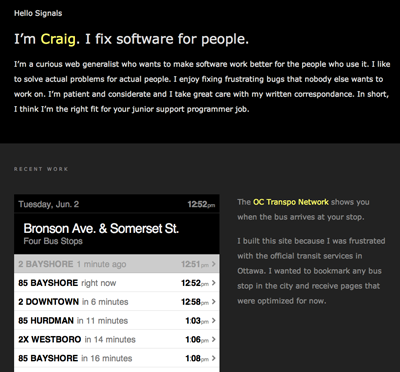Verifiable (shut down August 1, 2010)
 Stuart Roseman shut down Verifiable, a crowdsourced charting and data analysis site, to start SaneBox, a product that automatically identifies important email and separates them in a user’s inbox. Below, he explains how he knew when it was time to pull the plug on Verifiable.
Stuart Roseman shut down Verifiable, a crowdsourced charting and data analysis site, to start SaneBox, a product that automatically identifies important email and separates them in a user’s inbox. Below, he explains how he knew when it was time to pull the plug on Verifiable.
“We couldn’t charge for it. It was pretty clear. I’ve done this for a long time. I said, ‘This is a bad idea. I need a new idea.’
“The Verifiable problem still exists. It hasn’t been solved. There’s still chart junk. It’s got to be easier. But Verifiable was something I thought the world needed. SaneBox was something the world was asking for.
“My new mantra is: ‘I will make a product that people want to pay for and that they will be happy to pay for.’ I wake up in the morning and I say that. And I go to sleep at night and say that. It really changes everything.”
Related: “Out with the old business, in with the new”
Wesabe (shut down June 30, 2010)
Wesabe launched as a site to help people manage their personal finances. While competitor Mint was acquired by Intuit, Wesabe eventually shut down. In “Why Wesabe Lost to Mint,” Marc Hedlund dissects what happened.
“Mint focused on making the user do almost no work at all, by automatically editing and categorizing their data, reducing the number of fields in their signup form, and giving them immediate gratification as soon as they possibly could; we completely sucked at all of that…I was focused on trying to make the usability of editing data as easy and functional as it could be; Mint was focused on making it so you never had to do that at all. Their approach completely kicked our approach’s ass.
“You’ll hear a lot about why company A won and company B lost in any market, and in my experience, a lot of the theories thrown about — even or especially by the participants — are utter crap. A domain name doesn’t win you a market; launching second or fifth or tenth doesn’t lose you a market. You can’t blame your competitors or your board or the lack of or excess of investment. Focus on what really matters: making users happy with your product as quickly as you can, and helping them as much as you can after that. If you do those better than anyone else out there you’ll win.”
Related: “Wesabe is discontinuing its Accounts tab as of July 31st”
Storytlr (shut down February 24, 2009)
Storytlr let members create their own lifestreaming service (i.e. connecting Twitter, Flickr, Last.fm, and other accounts) at their own URL. Founder Laurent Eschenauer on what happened:
 “Storytlr started as a personal project to power my own site. People liked it, so we decided to build a nice UI and start hosting it for others. We were developing and operating the service next to our day job and families. We were quickly successfull, reaching beyond 10,000 users quickly and this meant a lot of strains on our lives (maintenance, support, etc.) and budget (~500$ monthly hosting bill) without any revenues.
“Storytlr started as a personal project to power my own site. People liked it, so we decided to build a nice UI and start hosting it for others. We were developing and operating the service next to our day job and families. We were quickly successfull, reaching beyond 10,000 users quickly and this meant a lot of strains on our lives (maintenance, support, etc.) and budget (~500$ monthly hosting bill) without any revenues.
“At that point, we started researching potential revenue models and investors, but quickly realized that the service was not well suited for a strong revenue stream. It was a tough choice, but, for the security of our families, we decided to pull the plug.”
Related: Laurent Eschenauer pitches Storytlr to Google’s Sergey Brin
TwitApps (shut down September 13, 2009)
Stuart Dallas created TwitApps as a technical exercise for himself. But after some early blog coverage, it attracted 4000 active users (and that number was growing). Despite that base, he couldn’t turn it into a product that was worth the effort.
“I considered the whole thing to be a toy project for a long time and it took me a while to realize that people were starting to rely on the service.
“Once you’ve established a free service and that service has other free competition, it’s very difficult to monetize it. It’s also very hard to change people’s impression of what something is once they’ve decided for themselves.”
“It became difficult to juggle the time demands of supporting TwitApps with the requirements of a full time job, several contracts and the need for downtime. In the end something had to go and it was clearly going to be the bit that wasn’t earning any money.”
Related: “TwitApps shutting down”
Continued…



 When they launched the Interspire Shopping Cart, it attracted thousands of businesses. Customers weren’t completely satisfied with the installable software though. Harper says, “We had so many people telling us how awesome it was, but that they didn’t want to have to deal with finding their own servers, installing it, upgrading it, etc. So that’s where the idea for BigCommerce came from.” BigCommerce lets customers create customized online stores via the web. These retailers can then access orders, products, inventory, and more without ever having to download any software.
When they launched the Interspire Shopping Cart, it attracted thousands of businesses. Customers weren’t completely satisfied with the installable software though. Harper says, “We had so many people telling us how awesome it was, but that they didn’t want to have to deal with finding their own servers, installing it, upgrading it, etc. So that’s where the idea for BigCommerce came from.” BigCommerce lets customers create customized online stores via the web. These retailers can then access orders, products, inventory, and more without ever having to download any software.




 InsuranceAgents.com co-founders Seth Kravitz (left) and Lev Barinskiy. (Photo: Jonathan Robert Willis for
InsuranceAgents.com co-founders Seth Kravitz (left) and Lev Barinskiy. (Photo: Jonathan Robert Willis for  Stuart Roseman shut down
Stuart Roseman shut down  “Storytlr started as a personal project to power my own site. People liked it, so we decided to build a nice UI and start hosting it for others. We were developing and operating the service next to our day job and families. We were quickly successfull, reaching beyond 10,000 users quickly and this meant a lot of strains on our lives (maintenance, support, etc.) and budget (~500$ monthly hosting bill) without any revenues.
“Storytlr started as a personal project to power my own site. People liked it, so we decided to build a nice UI and start hosting it for others. We were developing and operating the service next to our day job and families. We were quickly successfull, reaching beyond 10,000 users quickly and this meant a lot of strains on our lives (maintenance, support, etc.) and budget (~500$ monthly hosting bill) without any revenues.